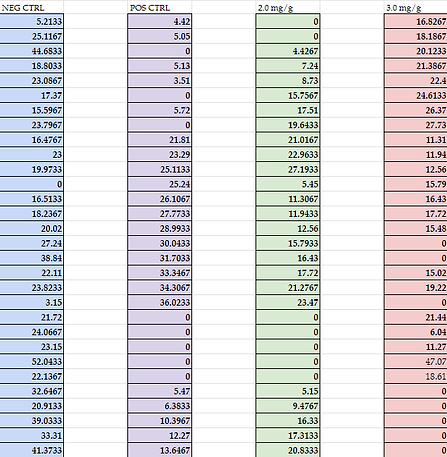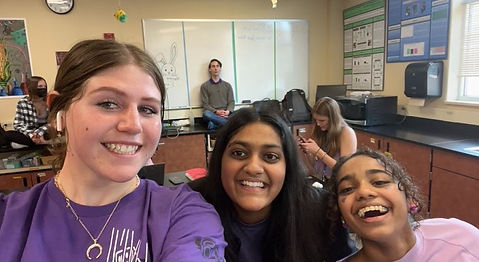Research Updates!
As my project progresses, I will be documenting all important events and results on this page!

Research Approved!
November 9, 2022
My love for this topic actually started last year in my Biotechnology class. During the entirety of my junior year, I worked with bs Drosophila to test the effectiveness of curcumin in reducing seizure times. After a year of hard work, my research shows that curcumin is in fact a viable treatment for reducing seizure times specifically in these model organisms. That's when inspiration hit me for this year: Would different dosages of curcumin have more or less of an effect on seizure recovery times? Now with an idea in place, I started my research. I was able to use several sites that I found last year to build my context but I struggled to come up with an assay to collect my data with. So, I turned to Dr. Baines, a professor in Manchester who helped me last year. After emailing him, we agreed that a visual assay would be the most viable given my time restraints and lab restraints. With my idea being fully planned out, I pitched my research to Ms. Dobos and got the green flag to actually start my experiment!
Introduction
February 20, 2023

This is an example of one of my many culture vials filled with Drosophila Melanogaster. This particular vial was initially made in late January and has just now began to fully flourish. This puts into perspective how long some vials took to start hatching enough flies to run pre-trials and experimental trials
Epilepsy is a disorder of the central nervous system (CNS) caused by abnormal electrical activity in the brain. It affects millions of people worldwide, but treatment is virtually inaccessible in low-income countries. While there are many FDA approved Anti-Epileptic Drugs (AEDs) to treat epilepsy in humans, these drugs are expensive and usually can only be found in a hospital. This is why many scientists are exploring more affordable and accessible alternatives to approved treatments.
My research will be testing different dosages of curcumin and its effect on seizure recovery times in bs Julius seizure Drosophila melanogaster. Curcumin is a chemical compound derived from turmeric, the root of the Curcuma plant. It is commonly used as a natural supplement to attempt to treat and prevent a variety of health issues, specifically inflammation, pain, heart disease, and memory loss. Prior research does show that curcumin is effective in reducing seizure times in Drosophila melanogaster. With this in mind, I will be testing different dosages of curcumin and its effectiveness in its anti-epileptic properties on bs Julius Seizure Drosophila
I am currently conducting my experimental trials; I finished testing my negative control and am starting the trials for the rest of varied dosages. I will have to conduct more than one trial at once in order to ensure that I finish my research at time. After I finish data collection, I will analyze the data by watching all of the videos of the seizures and timing each individual seizure. I will then perform three two-tailed t-tests to test for statistical significance.
At the beginning of this process, I had trouble culturing flies. The first shipment of flies arrived dead so I had to reorder the flies. The flies, once they arrived, also took longer than expected to reproduce. This may be because of the cold weather that we were subject to in Colorado. To accommodate for this I decided to conduct more than one trial at once in order to speed up the data collection process.
Results/Conclusion
April 14, 2023

Figure 1: This graph helps visualize the average seizure recovery times of all of my experimental groups and my controls. As shown by the data, the experimental groups were more effective than the negative control but not as effective as the positive control.

Figure 2: This chart shows all of the p-values I acquired after performing each two sample T-test. As shown above, all of my p-values were greater than 0.05 meaning my data is statistically insignificant.

Picture 1: This data table shows all of my seizure recovery times that I timed after recording. These data points were all acquired through a visual assay. As seen above, some data points were outliers as the flies did not have seizures. This could have been due to the limitation of controlling the fly age.
Results:
I tested two control groups and two experimental groups, all with 30 flies each resulting in a total of 120 data points. Each fly was seized in a small vial and their seizure recovery time was recorded. Then, for data analysis, I would watch and time each individual fly seizure. After calculating the averages, I found that my negative control had an average seizure recovery time of 23.78144 secs, my positive control (1 mg of curcumin per gram of media) had an average seizure recovery time of 11.65111 secs, my first experimental control (2 mg of curcumin per gram of media) had an average seizure recovery time of 13.91789 secs and my second experimental control (3 mg of curcumin per gram of media) had an average seizure recovery time of 13.85822 secs (Fig 1.). Overall, while the higher dosages of curcumin were more effective than the negative control of no curcumin, they were not as effective as my positive control.
After collecting all my data, I performed 4 two sample T-tests to test for statistical significant. The first two T-tests tested my experimental groups to my negative control to see if the dosages were as effective, not as effective or more effective than no curcumin. Then the second two T-tests tested my experimental groups to my positive control to see if the dosages were as effective, not as effective or more effective than 1 mg/g of curcumin. I compared all my statistical tests to a p-value of 0.05. After running all my statistical tests, I found that all of my p-values were greater than 0.05, meaning all of my data was statistically insignificant (Fig. 2). This supports my null hypothesis that different dosages of curcumin have no effect on the seizure recovery times of Drosophila melanogaster.
Discussion:
I evaluated the effect of different dosages of curcumin on seizure recovery time in Drosophila melanogaster and hypothesized that a higher dosage of curcumin would lower seizure recovery time more than my positive control of 1 mg/g of curcumin. My results reject my hypothesis and support my null hypothesis as my data points were statistically insignificant. This may have been due to the small sample size that I had to work with due to time constraints, which led to data with high standard deviation. While my results are statistically insignificant, the average seizure recovery times show that a greater dosage of curcumin does not necessarily reduce seizure recovery times more than a smaller dosage.
Limitations:
One big limitation I had is that I only used a visual assay, so my seizure recovery time may have been slightly off due to human error. This was controlled for by taking the averages of three timing attempts; however, it could have introduced millisecond-level errors in my data. Another limitation could have been the age of the Drosophila. Although I euthanized the adults in a vial 72 hours before administering treatment, the flies could have hatched at any point during those 72 hours. Since the Drosophila needed to be at least 2 days old for seizure induction to work properly, there may have been some flies that were simply not old enough to seize properly. This likely accounts for the outliers in my data (Pic 1.). A third limitation was the fact that I had no way to test if the flies had ingested the treatment. Finally, the biggest limitation was the small sample size which resulted in a high standard deviation. This limitation could have easily caused the statistical insignificance in my data.
Conclusion
Epilepsy affects millions of people all over the world, especially those in low income countries, as they cannot afford or access scientifically validated AEDs. Due to this, many alternative treatments have been used to combat epilepsy, however; these have not been scientifically validated to be effective in reducing epilepsy. One such example is curcumin, a common root that is found worldwide. Testing curcumin helps add to the many studies done to make treatment more affordable and widespread for those who need it. There are a few next steps that could be taken to further this research, including performing RNA synthesis, testing different dosages of curcumin, testing other alternative treatments to AEDs, and using higher level model organisms. I was only able to use a visual assay to analyze our data due to both time and budget restraints; however, using RNA synthesis in the future could allow for data analysis on the actual pumilio levels in the Drosophila’s brain to see if curcumin really did increase PUM-2 gene expression. In terms of furthering this research within Drosophila, future research could be done to test other alternatives to AEDs, such as licorice root, as well as test different dosages of curcumin to see if more or less has a different effect on seizure recovery time. Another step that could be taken is moving the research to higher level model organisms and test curcumin on specifically mice and rats with mutations in the PUM-2 expression to further bridge the gap to testing curcumin on epilepsy in humans.
Reflection:
How did you handle the uncertainty of the research process?
During the research process, I learned the most important skill to have was resiliency. At first, I thought everything would go smoothly and I would run into minimal issues. However, I ran into much bigger roadblocks than I expected and the uncertainty of how my project would continue started to creep in. I learned to keep my head up and continue problem-solving, both by myself and with my mentors to push past the obstacles. I also had to stay flexible and change parts of my project to fit the time restraints and to break through the many pushbacks I had during this process.
What was the most important research skill you developed as a result of this process, and how might you apply it to your future endeavors?
The most important research skill I developed was problem-solving and flexibility. As problems arose and as my protocols didn't work perfectly, I had to learn how to work around and through certain obstacles. I used all my resources to decide what I could change and what I had to fix and this made me more resilient. Resilience, problem-solving and flexibility are all skills I will take with me for the rest of my life as I aspire to go into the field of medicine. The long journey of education has only begun for me and these skills will help we get through bad days and hard classes and exams as I navigate my future.

